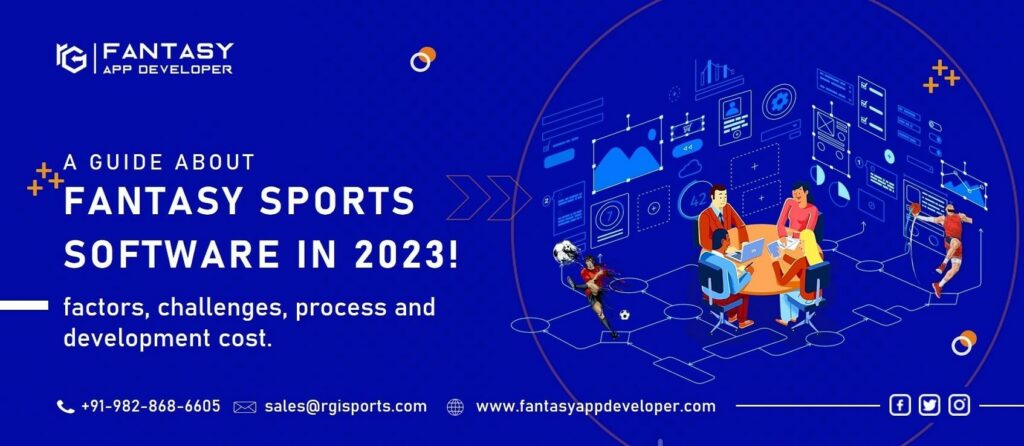Fantasy Sports has seen a surge in popularity in recent years, with an estimated revenue of $28.1 billion by 2023. The rise of the internet and mobile devices has made it easier for players to participate in various fantasy leagues, This rise has sparked the development of fantasy sports software that can support the industry.

Fantasy software is the backbone of any fantasy sports website. It automate the process of managing and organizing the game. DFS provide users with the ability to draft, trade, and manage their teams.
In this guide, we will discuss the factors that are shaping the future of fantasy sports platforms. Here, you get to know the process and the estimated development cost involved.
Factors affecting the future of Fantasy Sports Software
Fantasy Software are much essential tool to automate and smoothen the process. It also allows admins to perform their operations of transactions, reports, user engagement and much more. But there’re several factors that will surely affect the future of Fantasy Sports Software solutions. A few of these are here:
Advanced Analytics: As the industry continues to grow, the demand for sophisticated analytics tool is increasing. Fantasy software in 2023 will feature advanced analytics tools that can process and analyze vast amounts of data in real-time. This will help players to better understand the performance of their teams, players, and the competition.
Integration with Social Media: Social media integration is becoming an essential feature for many fantasy sports platforms. In 2023, OFS software will be designed to seamlessly integrate with Facebook, Twitter, and Instagram. This will allow players to share their experiences and connect with other players, boosting engagement and building a community around the platform.
Mobile Optimization: With the increasing popularity of mobile devices, it is critical that fantasy software is optimized for mobile devices. In 2023, fantasy platforms will be optimized for mobiles, allowing players to participate in leagues from anywhere.
Challenges in Fantasy Sports Software Development
Fantasy sports are highly adored by the youth of India and continuously witnessed growth in the previous decade. As per the stats, the online sports industry is estimated to be valued at around 54 billion in India which was 24 billing in FY21. With the forecasted CAGR of 38%, there’re several challenges associated with the development of such software solutions.
In 2023, the development of fantasy platforms faces several challenges, including:
- Regulations: Fantasy sports is subject to various state and federal regulations. And developers must ensure that their software complies with these regulations. This includes issues such as age verification, data privacy, and fair play.
- Integration with Real-Time Data: One of the key features of fantasy sports software is real-time player statistics, and integrating this data into the software can be a challenge. The software must be able to access and process large amounts of data quickly and accurately.
- User Experience: The software must provide a seamless and intuitive user experience, and developers must be able to handle the challenges of designing and testing software for multiple devices, including smartphones, tablets, and laptops.
- Security: The software must have robust security measures in place to protect user data and ensure the fairness of the competition. This includes issues such as SSL encryption, secure servers, and data backup.
- Scalability: The software must be able to handle a large number of users and support growth as the market expands. This requires developers to plan for scalability from the beginning and implement strategies for managing server loads and data storage.
- Customer Support: The software must have a dedicated customer support team to assist users with any questions or issues they may encounter. This requires additional resources and planning for customer support from the beginning of the development process.
- Competition: The fantasy sports software market is highly competitive, and developers must be able to differentiate their software from other products and offer unique features and capabilities.
Fantasy Sports Platform – Development Process
Having an idea of such kind of fantasy platform isn’t enough. But there’s always an in-depth process associated with the development of these fantasy apps. There are around 150 developers in India and each of them has a fixed set of processes that needs to be accomplished in the development.
The process of developing a fantasy sports platform involves several steps, including:
- Ideation and Planning: This is where you will come up with an idea for your platform and plan how you will build it. This stage involves an in-depth market research, competition analysis, and opportunity identification before the next move.
- Design and Development: This stage involves creating the platform’s design, developing the code, and integrating the various features and tools. For the success, design should be user-friendly, visually appealing, and optimized for mobile devices.
- Testing and Launch: Once the platform is complete, it is time to test it thoroughly to ensure it is working correctly. The platform will be ready to launch after all the bugs ironed out in the testing phase.
- Maintenance and support: Work hasn’t been done with the launch of fantasy sports software, but it’s time to analyze the actual data and its impact on the performance. After deployment, software needs ongoing maintenance and support to ensure that it continues to function smoothly.

The development cost of a Fantasy Solution
One of the major aspects of fantasy sports solutions is their cost, which can easily ruin or reshape several dreams. But the cost of developing Fantasy Sports Solutions varies based on the following factors:
- Size and complexity of the project
- Features and functionalities required
- Technology stack & Location
- Hourly rate & working hours of the development team
- Design and UX/UI cost
However, on average, the development cost of the Fantasy platform could range between $50,000 to $200,000. The actual cost will depend on the specific requirements and features of the project. For example, a simple fantasy sports platform with basic features might cost less, while a more complex platform with advanced features will cost more.
To ensure timely delivery, budget matching, and a high standard, working with a reputable development team that has experience in developing Fantasy Sports software is important .
Other than the scratch development, there’re other ways, like the subscription model, through which you can easily run a fantasy platform. These models are less costly in comparison to the scratch ones but have only fixed features and customization can increase the cost.
Conclusion – Final words
In conclusion, the future of fantasy sports software is looking bright, with advanced analytics, social media integration, and mobile optimization. Developing a fantasy sports platform requires careful planning and a solid understanding of the market and competition.
The development cost will vary based on the complexity of the software and the features required. But the potential rewards of building a successful sports platform need more effort. With the right software in place, users will get a seamless and efficient experience.
You may also like
-
Delhi Agra Jaipur Tour – Best Golden Triangle Tour Packages
-
Union Developers– A Trusted Real Estate Developer in Pakistan
-
Budget-Friendly Sustainable Canvas Bags in UAE That Make a Big Impact
-
How to Experience the Thrill of the Slope Game!
-
United Airlines Flight UA770 Emergency Diversion: A Closer Look
